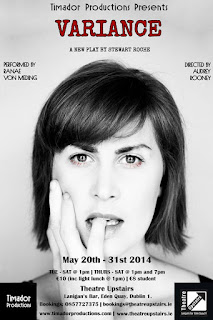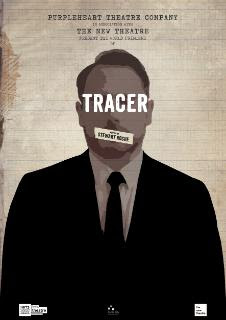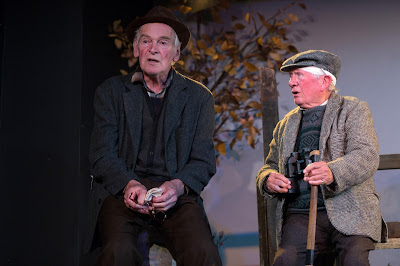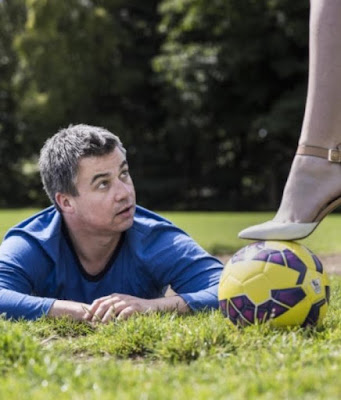![]() |
| Jeda deBrí & Katie McCann |
Stories of the circus are dotted around novels, films and musicals. A circus coming to town, or running off with one, has, for whatever reason, a romantic, exciting leaning and is the starting point for
Cirque Des Rêves, a new play by writer and actor Katie McCann, and director Jeda deBrí, which will take to the stage of
Smock Alley's Boys' School this week. While this isn't the first time McCann and deBrí have worked together (and between them they have stacked up an impressive array of acting, writing and directing credits)
Cirque Des Rêves does mark the first time both their production companies,
Illustrated Productions and
Sickle Moon Productions, have joined forces. Despite opening night being around the corner, McCann and deBrí managed to find time to chat with me about their newest collaboration.
As
Cirque Des Rêves is a new play, I asked McCann, to give me a flavour of what the tale is about, as well as a quick translation of the title. "
Cirque Des Rêves is 'Circus of Dreams'. It's a story, essentially, about a young girl, called Poppy Parker, who wishes to escape her life and she's very bored by her normal everyday life and has dreams of something a lot bigger, and believes that she's destined for a much more exciting life than the one planned for her by her family and school... and then one day a circus arrives in town and she sees this as a first step on a really big adventure. But unfortunately you should be careful what you wish for and things are never quite what they seem ... it is playing with that idea we all think that the grass is greener and we all imagine that the world is something else, but sometimes - most of the time - it's not."
What struck me initially were the images used in the poster, a Victorian, Penny Dreadful style. As it turns out McCann is a big fan of that period. "I'm sort of fascinated by the Victorian era and because it was such an interesting time in history and it was a very - we talk about nowadays how technology advanced very quickly - but for them it was very drastic; we sort of went from a phone that was plugged into a wall, to a phone we can travel around with, they went from nothing to phone, do you know." Her interest, fascination, and curiosity about this period of the past comes through as she continues talking.
"In the Victorian era they were very obsessed with ghosts," McCann continues, "and I've read a lot of articles and different things about why particularly they were obsessed with ghosts and a lot of it is to do with technology." She cites the telegraph as an example, as it offered communication between places but that communication was unseen, emphasising the idea of not having "to see things to understand, it was the first time that this was really very prevalent. You could hear something and it was a communication but you didn't know where it was coming from. And then also gaslight... gas was very noisy, it would creak in walls, and then the Industrial Revolution was changing the world. People were moving from different places, so stories like old country myths were coming to towns, and people were experiencing new cultures, that kind of stuff, and I've always just loved that time ... and as well, because they sort of believed in magic a little bit more than we do and they were slightly less sceptical. When you have characters who completely believe in something it's much easier for an audience to invest in that, so it's kind of going, if we put these people on stage you can already go 'I can go with this, I understand this world even though it's different to my own'; allow that suspension of disbelief a little bit."
![]() |
| Katie McCann |
"The Victorian era is so iconic," deBrí adds, "that's kind of what we're doing with the images - obviously Ste Murray is a huge collaborator of ours, we're a big fan of his." Murray is responsible for a number of theatre posters for many companies in recent times, and has created posters for both Sickle Moon and Illustrated Productions. "It's great, the whole photography of that era and staging ghost photography and seances," deBrí continues, "we were very, very interested in that, so with the images and the poster, we looked at a lot of tintype photography and how they printed onto tin, and we were very influenced by that."
Photography is something deBrí knows quite a bit about having come from a film and photography background, rather than a theatrical one, and adding that "I'm still a huge, big fan of film, I try to make at least one film a year, if I can." It was through actor and writer Finbarr Doyle, who approached her with a script, that the fork in the road came. "It was a small production I dipped my toes into, and caught the bug. And then when you're surrounded by so many talented people, it's just impossible to stop."
Also on board for this show, both tell me, is costume designer Nicola Burke, a tailor by trade. "She's phenomenal"
is McCann's one word summary of Burke, with deBrí adding: "We've known her for a long time. She's collaborated with us on a lot of our productions before. She's a big fan of Victorian era stuff and menswear specifically. So we come to her and she goes 'well there were no pockets then, they just didn't have pockets, so we're not going to have pockets'." It does show a great attention to detail, something I've seen before in productions directed by deBrí, so it is not surprising that others on the team have this approach.
Both photography and theatre are visual, something which I put to deBrí. "I'm a big fan of visuals and constructing things around, like having everything coming from a production to be the same, to be of the same family and if you see an image from that you instantly recognise that as being from Cirque. It's something we look at very closely." To get this unity of look, costumes and photography are started early, which involves a lot of collaboration.
![]()
Collaboration is an important part, no doubt why the two companies in this instance have come together. McCann and deBrí have worked before previously with
Slippers written by deBrí and Finbarr Doyle, where McCann played the role of Jean under De Brí's direction. This was followed up by
Tales from Briar Hall, written by McCann, where she played the role of Daisy. A month after
Briar Hall, McCann mentioned a 'wacky idea' to deBrí: haunted circus, and left the thought with her.
A year later, and it's ready to open at the Boys' school in Smock Alley in Halloween week, closing on Halloween itself. "We're big fans of Halloween at Sickle Moon. Huge fans," deBrí says. "We go with the dark ideas. I mean all of our scripts are fairly dark and then the best thing about collaborating with Katie is that while all the scripts that myself and Finbarr would write are very dark, a lot of them are character studies, you know, like how do these characters react to these strange worlds, whereas Katie brings with her scripts, they're just a completely different world, whereas our scripts are kind of rooted in the real-world and the darkness in the real-world, Katie is like what happens if we just throwout the real world and just go mad, and that's a fantastic thing about working with Katie is that we can go mad and create these fantastical worlds."
McCann feels that a balance has occurred over time through previous collaborations. "If I create the world, then Jeda can create the characters, and bring a focus and a detail that's needed to make that world real. You can have an idea but you need the follow through... the detail is all there that makes it real, even if it isn't our reality, it's real to someone, because it's real to those characters and that's what you buy into, and that's what makes it a production that's worth seeing.""They are stories that everybody can identify with as well," deBrí adds, "it's the running away to the circus, it's the classic Gothic literature, or Victorian literature, it's Jekyll and Hyde, it's what would happen on the other side if I had the chance to take that leap."
![]() |
| Finbarr Doyle |
Story, characters and the world they inhabit come across as the main focus in their work. For
Cirque Des Rêves, and working with similar designers, they have also brought together a strong cast, from Finbarr Doyle, Clodagh Mooney Duggan, McCann herself, and Kevin C Olohan, many who while acting, have also worked as writers and directors in their own right, highlighting the talent that is emerging in the city at this time that is both exciting, and has a somewhat rep feel to it.
"We were very fortunate in that, with this production in particular," McCann says, "we were able to approach people quite a bit in advance ... we approached it in a different way." That different way was to let everyone feel they were really involved in the production. "And that they own it," deBrí says. This meant starting a lot earlier and letting those involved know that their input was valued and taken on. It also meant they weren't afraid of changing things, as McCann recounts: "There was one character I had in my head one way and then the actor read it far better than I would ever have imagined it, and suddenly I had to rewrite the way he spoke, the character spoke, because suddenly it was like, no he's not that way he's actually this way because this actor had brought that character to life in this way. And that was a really rare opportunity to have that level of collaboration and with such talented people. And they are so giving of their time, and their energy and that's really extraordinary to see, and as a writer and director it's just brilliant to be in that room and have people go 'what about this?' and you're like 'Totally'."
![]() |
| Clodagh Mooney Duggan |
"I think, you know, this generation of theatre makers is just absolutely fantastic. We have an amazing pool of people to choose from and to work with," deBrí says, her voice underling her admiration and excitement of this reality. Of course, it is easy to say that, particularly if you are of the generation you are talking about, but her point is one I have reflected on a number of times and come to similar conclusions; there are a large number of very talented theatre makers working as actors, directors and designers, and producers, creating a wide variety of work.
"I think that there's a sense of," McCann adds, "that you don't just have to be one thing, I think that this is a thing I've noticed in the last while, is that I don't feel like I just have to be an actor, I can be a writer and a producer as well, and I think this idea, I think actually the idea of making theatre and creating it was really instilled in me in
the Gaiety School ... it's like a drive instilled in college." It is this drive, knowing there are many aspects to making theatre than 'only acting', or 'only directing', that is underlying this burst in the creative and collaborative nature of young theatre professionals today.
There is also the old notion of waiting for the phone to ring that isn't what this generation of actors are doing."A lot of the time people kind of tell you it's all out of your control," McCann says, "that you have to wait for the phone to ring, and I am just not that type of person. And I think more and more it's happening now where people don't feel like they should have to. They have ideas, they have things they want to say and why can't I go out and do that. I think that's what's amazing about a lot of our peers...is this sense of I can take control of this, I can go out there and I can put on a show and I can do that, there is the option of that and have ownership of your own career as opposed to waiting."
It is this 'get up and go feeling' that is contributing to new plays being produced by writing actors and newly formed production companies. McCann notes that for her the beauty of making theatre is not about waiting, it's about "telling stories that need to be told and I think
Cirque was a story that we wanted to tell, and we wanted to tell it with this group of people and it's just been an absolute joy."
Another feature of telling this story will be with originally composed songs and score by Eoghan O'Shaughnessy, as well as traditional songs with new arrangements, from Agnes Banti and Silvia Lombardi Francois, which is a first for both McCann and deBrí. They do point out that it's a play with music, influenced more by film music than musical theatre. For them, it was bringing in ideas that they like but haven't used before, extending that 'get up and go' attitude into the production itself, to both challenge and to create something different, and to give things a go and see where it takes them.
![]() |
| Kevin C Olohan |
In the build up to the show, they performed a preview in McCann's old primary school in Wexford for the pupils and their parents, without a set, lights or music. What struck them was how young and old reacted to it and got the same enjoyment out of it, not that it is children's theatre, but how engaged they were with the storytelling. "It's a dark story and we haven't shied away from that at all, but we've taken them in hand and very thoughtfully and carefully guided them through a dark story and gone 'don't worry, we have you, you're safe' and that kind of thing really interests me and I would love to do more stuff like that," McCann says.
"There is a lot of comedy involved in it as well," deBrí says, something that is prevalent in McCann's
Briar Hall, but as for the future, "looking forward, I mean, coming from last year and the amazing year that we had in
Theatre Upstairs, and that fantastic opportunity that we had to produce our own work, and we just want to go forward and keep producing our own work, and pushing the envelope as well, because certainly with last year we kept telling ourselves that we'll just go even more different with the next script, and madder, and bigger and better and I think this is what we've been doing with
Cirque as well."
While Cirque has four players, the play itself has twenty characters, which will be a challenge for the talented group they have assembled, but is all part of going different, and bigger and better, something they are not afraid of and willingly embrace. But from talking with them, the core is storytelling and characters. McCann and deBrí may not have run off with a circus themselves, but they have gone one better, and created their own in Cirque Des Rêves.
-
During the week long run, they have a few surprises in store, like a puppet workshop for children following the matinee on Halloween, and a costume competition for the audience on Halloween night.Cirque De Reves
(Suitable for 9+)
CAST:
Cast: Clodagh Mooney Duggan, Finbarr Doyle, Katie McCann and Kevin C Olohan
CREATIVE TEAM:
Writer: Katie McCann
Director: Jeda deBrí
Set Design: Aoife Fealy
Costume: Nicola Burke
Composer: Eoghan O’Shaughnessy
Musical Arranger: Agnese Banti
Musical Arranger / Vocal Coach: Silvia Lombardi François
Visual Design: Ste Murray
DATES & TIMES:
Mon 26th - Sat 31st October 2015 @ 8pm
Matinee Saturday 31st @ 2:30pm
LOCATION:
Smock Alley, Boys’ School.
TICKETS:
€12/€10/€8
SPECIAL OFFERS:
Preview – Two tickets for €10
Matinee Saturday 31st – Kids under 16 for €8 followed by a Halloween Workshop for children and parents
































